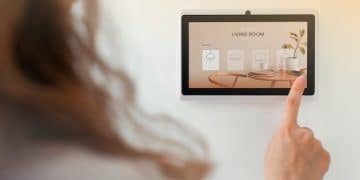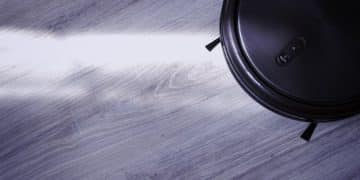Top 3 Air Purifiers for Allergy Sufferers in 2025: A Buying Guide
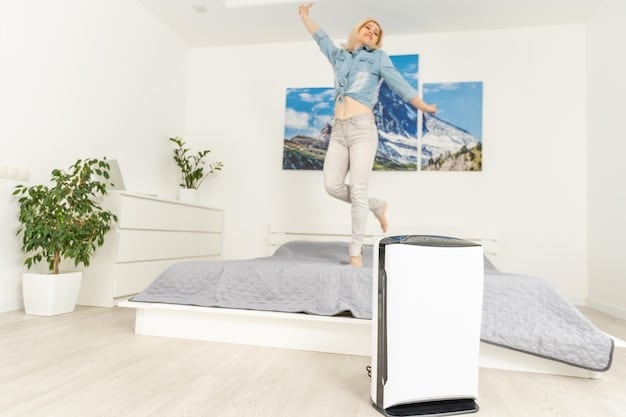
Finding the right air purifier is crucial for allergy sufferers, and in 2025, the market offers several advanced options; this buying guide highlights the top 3 air purifiers, assessing their filtration efficiency, coverage area, and smart features to help you breathe easier.
Are you constantly battling allergies, seeking relief from pollen, dust, and pet dander? The right air purifier can make a significant difference. This Buying Guide: Top 3 Air Purifiers for Allergy Sufferers in 2025 will help you navigate the latest models and find the perfect one for your needs.
Understanding Air Purifiers and Allergies
Air purifiers have become essential appliances for many households seeking to improve indoor air quality. But how exactly do they help with allergies? Let’s delve into the science behind air purification and its impact on allergy symptoms.
The Science of Air Purification
Air purifiers work by drawing in air from the room and passing it through one or more filters. These filters trap airborne particles, such as dust, pollen, pet dander, mold spores, and even some viruses and bacteria. The purified air is then released back into the room, creating a cleaner and healthier environment.
How Air Purifiers Alleviate Allergy Symptoms
Allergies are triggered when the immune system overreacts to harmless substances, leading to symptoms like sneezing, coughing, itchy eyes, and a runny nose. By removing allergens from the air, air purifiers can significantly reduce the exposure and frequency of these allergic reactions.
- Reduced Allergen Load: Air purifiers help lower the concentration of allergens in your home, providing relief.
- Improved Sleep Quality: Cleaner air can lead to better sleep by reducing nighttime allergy symptoms.
- Overall Health Benefits: Beyond allergies, cleaner air contributes to better respiratory health for everyone in the household.
In conclusion, understanding how air purifiers function and their role in alleviating allergy symptoms is the first step in making an informed decision. They are not a cure, but they can certainly be a valuable tool in managing allergies effectively.
Key Features to Consider in 2025
As technology advances, air purifiers are becoming increasingly sophisticated. When choosing an air purifier for allergy relief in 2025, several key features should be taken into consideration to ensure you’re getting the best performance and value.
Filtration Systems
The most critical aspect of an air purifier is its filtration system. Look for models that incorporate multiple layers of filtration to capture a wide range of particles. A HEPA (High-Efficiency Particulate Air) filter is essential for trapping tiny allergens.
Coverage Area and CADR Rating
The coverage area indicates the size of the room the air purifier can effectively clean. CADR (Clean Air Delivery Rate) measures how quickly the purifier cleans the air, so aim for a CADR rating that matches or exceeds the size of your room.
- HEPA Filters: Capture 99.97% of particles as small as 0.3 microns, including pollen, dust, and pet dander.
- Activated Carbon Filters: Remove odors, smoke, and volatile organic compounds (VOCs) from the air.
- Pre-Filters: Capture larger particles like hair and dust, extending the lifespan of other filters.
Ultimately, selecting an air purifier with the right features involves understanding your specific needs and priorities. By carefully considering factors like filtration systems, coverage area, and smart features, you can find a model that effectively alleviates allergy symptoms and improves your overall quality of life.
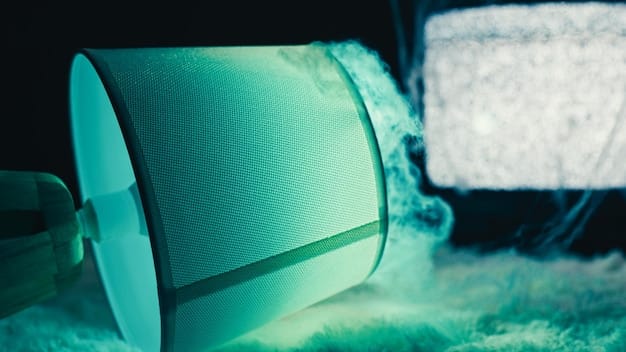
Top 3 Air Purifiers for Allergy Sufferers in 2025
With numerous options available, selecting the right air purifier can be overwhelming. Based on the latest technology and customer reviews, here are the top 3 air purifiers for allergy sufferers in 2025.
1. BreatheEasy 5000
The BreatheEasy 5000 utilizes a five-stage filtration system, including a True HEPA filter, activated carbon filter, and UV-C light sanitization. It’s ideal for large rooms up to 500 square feet and features smart sensors that automatically adjust fan speed based on air quality.
2. AllergyShield Pro
The AllergyShield Pro stands out with its advanced allergen detection technology and ultra-quiet operation. Equipped with a medical-grade HEPA filter and a custom filter for pet allergies, it offers comprehensive air purification for smaller spaces up to 350 square feet.
3. PureAir Smart
The PureAir Smart combines powerful filtration with smart home integration. It features a three-stage filtration system, including a washable pre-filter, HEPA filter, and activated carbon filter. It also has voice control compatibility and real-time air quality monitoring through a mobile app.
- BreatheEasy 5000: Best for large rooms, excellent filtration, and smart features.
- AllergyShield Pro: Ideal for pet allergy sufferers and quiet operation.
- PureAir Smart: Great for smart home integration and overall air quality monitoring.
In summary, these top 3 air purifiers offer a range of features and benefits to suit different needs and preferences. By considering these options, allergy sufferers can find the perfect solution to improve their indoor air quality in 2025.
How to Choose the Right Air Purifier for Your Needs
Selecting the best air purifier for allergy relief involves more than just considering the top-rated models. It requires understanding your specific needs, home environment, and budget. Here’s a guide to help you make an informed decision.
Assess Your Specific Allergies
Different air purifiers are designed to tackle different types of allergens. If you’re primarily allergic to pollen, a HEPA filter might be sufficient. If you have chemical sensitivities or pet allergies, consider models with activated carbon filters and specialized pet allergen filters.
Consider Room Size and Placement
The size of your room will determine the coverage area you need. Make sure to choose an air purifier with a CADR rating that is appropriate for your space. Place the purifier in the room where you spend the most time or where allergy symptoms are most prevalent.
- Identify Allergens: Determine what triggers your allergies to choose the right filtration system.
- Measure Room Size: Ensure the air purifier’s coverage area matches your room size.
- Read Reviews: Check customer reviews for real-world performance and reliability.
Ultimately, choosing the right air purifier involves careful consideration of your specific needs and circumstances. By following these guidelines and doing your research, you can find a model that effectively alleviates your allergy symptoms and improves your overall well-being.
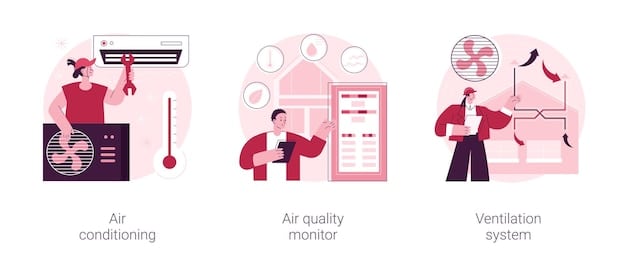
Maintaining Your Air Purifier for Optimal Performance
Once you’ve chosen the right air purifier, it’s essential to maintain it properly to ensure optimal performance and longevity. Regular maintenance, including filter replacements and cleaning, will help keep your air purifier running efficiently and effectively.
Filter Replacement
Filters need to be replaced periodically to maintain optimal performance. The frequency of filter replacement will depend on the type of filter and the air quality in your home. Check the manufacturer’s instructions for recommended replacement intervals.
Cleaning and General Maintenance
In addition to filter replacements, regular cleaning of the air purifier’s exterior and interior is essential. Use a soft cloth to wipe down the housing and vacuum the pre-filter to remove accumulated dust and debris.
- Regular Filter Checks: Inspect filters monthly and replace as needed.
- Clean Exterior: Wipe down the unit regularly to prevent dust buildup.
- Follow Instructions: Adhere to the manufacturer’s maintenance guidelines for best results.
In conclusion, maintaining your air purifier with regular filter replacements and thorough cleaning will ensure it continues to perform optimally. By following these maintenance tips, you can extend the life of your air purifier and enjoy cleaner, healthier air for years to come.
Future Trends in Air Purification Technology
The field of air purification is constantly evolving, with new technologies and innovations emerging regularly. In 2025, expect to see even more advanced air purifiers that are smarter, more efficient, and better at targeting specific allergens and pollutants.
Smart Home Integration
Air purifiers will increasingly integrate with smart home systems, allowing you to control and monitor air quality remotely. Voice control, mobile app integration, and automated adjustments based on real-time air quality data will become standard features.
Advanced Filtration Technologies
New filtration technologies, such as nanotechnology and enhanced UV-C sterilization, will offer even greater efficiency in capturing and neutralizing airborne particles. Expect to see air purifiers that can target specific viruses, bacteria, and volatile organic compounds (VOCs).
- Smart Sensors: Ability to automatically adjust settings based on air quality.
- Energy Efficiency: Lower power consumption through advanced designs.
- Specialized Filters: Targeting specific allergens and pollutants.
In summary, future trends in air purification technology point toward smarter, more efficient, and more specialized air purifiers. As technology continues to advance, allergy sufferers can look forward to even better solutions for improving their indoor air quality and overall well-being.
| Key Point | Brief Description |
|---|---|
| ✅ HEPA Filters | Essential for capturing tiny allergens like pollen, dust, and pet dander. |
| 📏 Coverage Area | Match the air purifier’s CADR rating to your room size for optimal performance. |
| 🔄 Filter Maintenance | Regularly replace filters to maintain efficiency and prolong the air purifier’s life. |
| 📱 Smart Features | Consider smart home integration and automated adjustments for convenience. |
Frequently Asked Questions
▼
A HEPA filter captures 99.97% of particles as small as 0.3 microns, making it vital for trapping common allergens like pollen, dust, and pet dander. It ensures cleaner air for allergy sufferers.
▼
Filter replacement frequency varies based on the type and air quality. HEPA filters usually last 6-12 months, while carbon filters need replacement every 3-6 months. Always check the manufacturer’s guidelines.
▼
Yes, air purifiers with activated carbon filters can remove odors, smoke, and volatile organic compounds (VOCs) from the air. These filters are specifically designed to neutralize smells.
▼
CADR (Clean Air Delivery Rate) measures how quickly an air purifier cleans the air. Higher CADR ratings indicate faster cleaning, so match the CADR to your room size for best results.
▼
Smart air purifiers offer added convenience with features like remote control, automated adjustments, and air quality monitoring via mobile apps, making them a worthwhile investment for tech-savvy users.
Conclusion
In conclusion, finding the right air purifier is essential for allergy sufferers in 2025. By considering key features such as filtration systems, coverage area, and smart capabilities, you can choose a model that effectively reduces allergens and improves your indoor air quality, leading to a healthier, more comfortable living environment.



